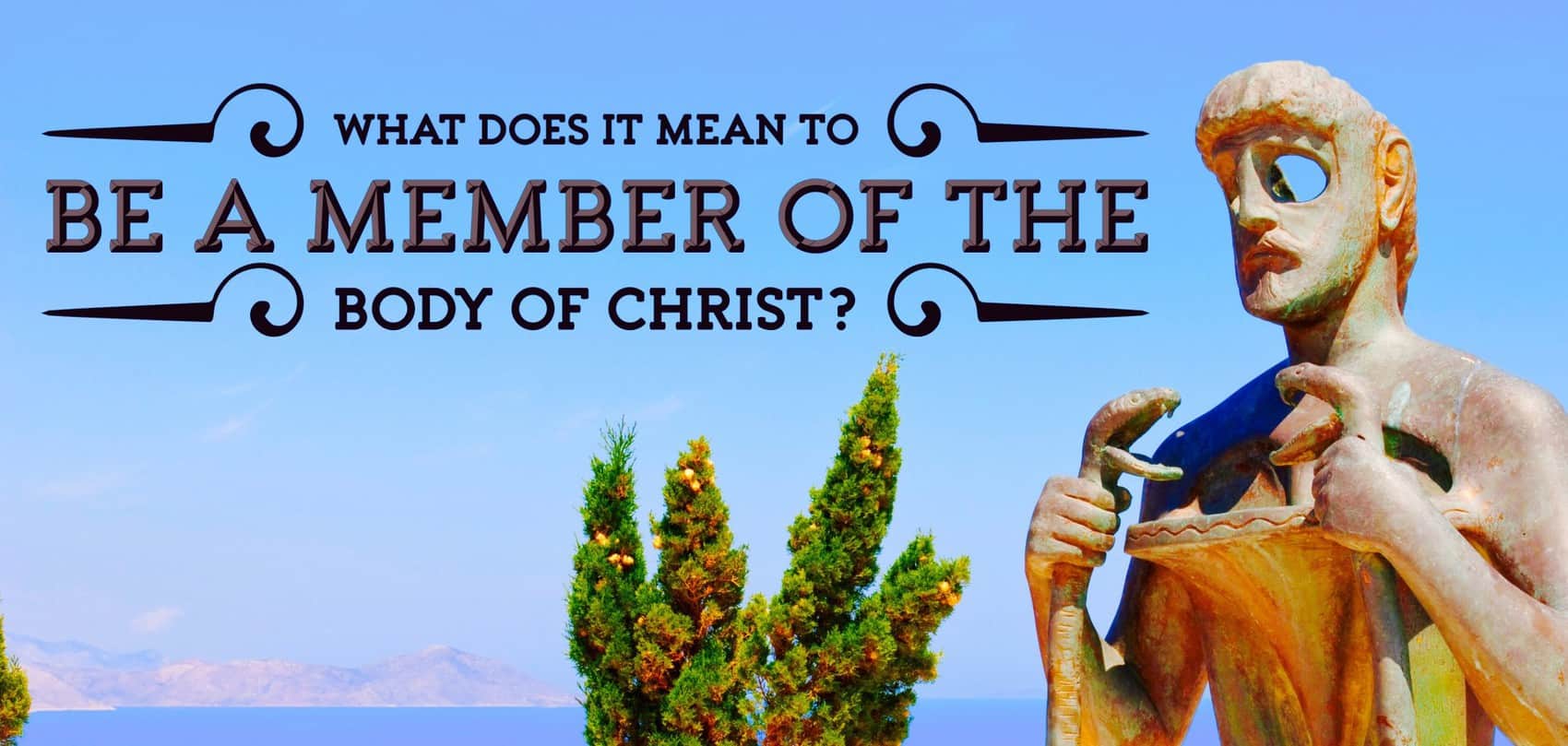In a grove of trees south of the city of Corinth stood the Asklepion, an ancient temple dedicated to the god of healing (pictured above). Every year, thousands of women and men made pilgrimages to this temple to seek relief for their bodies. Worshipers who believed that they received healing in this place left behind an odd sort of testimony to their experience. They made terra-cotta images of whatever body part had been healed and placed these images in the temple. And so, within the Asklepion, disjointed images of legs, arms, eyes, ears, and other body parts encouraged pilgrims that they too could find healing in this shrine. Still today, in a nearby museum, visitors to Corinth can see the body parts that have been unearthed from the site of the ancient temple.
It is possible—though not certain—that the apostle Paul had these disjointed body parts from a pagan shrine in mind when he reminded the Corinthians that, unlike the body parts scattered around the Asklepion, the many parts of Christ’s church constitute “one body” (1 Corinthians 12:22). Regardless of whether Paul had the Asklepion in mind when he wrote, this much is certain: the Corinthian Christians were behaving like a pile of disjointed body parts, refusing to function in harmony with one another. Part of Paul’s point in 1 Corinthians was to remind them that, because God had made them one body in Jesus Christ, they were called to work in unity with one another.
What Was Happening in the Body of Christ in the City of Corinth?
Paul had first proclaimed the gospel in Corinth around the year A.D. 50, two decades or so after Jesus rose from the dead. Despite resistance from some local religious leaders, a decision from the Roman proconsul Lucius Junius Gallio enabled Paul to preach freely for almost two years (see Acts 18:12-18). By the time Paul left the city, he had planted a promising church in the key coastal city of Corinth.
In A.D. 54 or 55, a few members from the Corinthian church—“Chloe’s people,” in Paul’s parlance (1 Corinthians 1:11)—tracked down the apostle in the city of Ephesus. Chloe’s people brought some positive news. God had “enriched” the Corinthians with knowledge and revealed his grace among them through manifold “spiritual gifts” (1 Corinthians 1:7). Not all the news from Corinth was so good, however. The very outpouring of knowledge and spiritual gifts that should have drawn the Corinthian Christians closer together had resulted instead in ranking and schisms. Some members of the Corinthian church had turned their focus toward whose spiritual gifts seemed the most dramatic and toward which groups in the church could boast the best apostolic pedigrees (1 Corinthians 1:11-13).
In Paul’s letter to the church in Corinth, he made it clear that such schisms had no place among God’s people. To rank believers according to fleeting “manifestations of the Spirit” was to magnify the status of individuals instead of building up the whole community of faith (1 Corinthians 14:4-12). To identify oneself with specific teachers was to behave in ways that were “merely human” (1 Corinthians 3:4). These patterns were deeply problematic because the Christians in Corinth did not belong to themselves or even to certain apostles or teachers; they had been “bought with a price” (1 Corinthians 6:20). They were the property of Jesus Christ himself, and their identity was rooted in the gospel of Christ (1 Corinthians 3:21-23; 9:16-18).
Further complicating the Corinthian situation, the same members who boasted about their knowledge and spiritual experiences may also have enjoyed a higher socio-economic status. They saw themselves as “strong” and superior not only to their “weaker brothers” but perhaps even to the apostles (1 Corinthians 4:9-10; 8:7–9:2). This disdain for those with less impressive knowledge and gifts showed clearly in the church’s worship and in their celebrations of the Lord’s Supper (1 Corinthians 11:17-34; 14:1-12).
In his instructions about the Lord’s Supper, Paul urged each Christian in Corinth to consider carefully the entire “body”—that is, not only oneself but also each fellow member of the church–whenever they participated in this symbolic meal (1 Corinthians 11:29). A few lines later, Paul began to build on this metaphor of the church as a body, pointing out how both the human body and the church were “one with many members” (1 Corinthians 12:12).
Some aspects of this metaphor of the body would have been quite familiar to Paul’s first readers. What Paul did with the metaphor, however, was very different from anything they had ever heard before.
Ancient Homonoia Speeches and Paul’s Body Metaphor
“All the members of the body, though many, are one body,” Paul wrote (1 Corinthians 12:12), and at least a few hearers in Corinth would have immediately assumed that they knew where Paul was headed. This was, after all, an idea that the cultured Corinthians had heard before–though perhaps not from any Christian teacher.
The metaphor of one body with many members working together was a common feature in a form of Greek and Roman political rhetoric known as the “homonoia speech.” The Greek word “homonoia” meant “like-mindedness” and referred to the concord that unified a city-state or other political entity. Homonoia speeches typically called people to stop their conflict for the sake of the greater good of their society. Such speeches frequently drew an analogy between the harmonious function of different body parts and the ways that people should work together.
For example, five centuries before the birth of Jesus, soldiers from the lower classes of Roman society had protested the excessive wealth and power of the upper class. To regain the soldiers’ support, the consul told a fable in which the hands, mouth, and teeth of a body refused to provide food to the stomach because the stomach was not doing enough for them. The entire body was quickly “reduced to the last stage of exhaustion”; that is what the consul predicted for the city of Rome if the plebeian soldiers did not support the “stomach” and perform their duties. The soldiers responded by renewing their support for Rome. In 43 B.C., as the Roman Republic gave way to the rising Empire, the lawyer Cicero described how a society would become weak if any “bodily member” began to believe that it could remain healthy by borrowing strength from other parts of the body. Writing in the early decades of the growth of Christianity, the Greek historian Plutarch likened the twofold nature of nostrils, ears, eyes, hands, and feet to the way that brothers should relate to one another—and these analogies are only a few of many examples that may be found in ancient literature.
Paul’s body metaphor stands within a long and familiar tradition in Greek and Roman rhetoric. As in the story of what happened when hand, mouth, and teeth refused to feed to stomach, Paul personified different parts of the body. Just like Plutarch in his comparison of the brothers, Paul used ears, eyes, hands, and feet to make his point. Yet these similarities between Paul and previous writers must not overshadow a crucial twist in the text that sets Paul’s analogy completely apart!
What Paul Did Differently
Paul, inspired by the Holy Spirit, did far more than merely mimic an analogy that most people had heard before. In usages of this metaphor outside the New Testament, the speaker’s purpose was typically to call less honored members of society to submit to those that enjoyed greater skills or social status. The purpose of the body metaphor was to solidify a social hierarchy among people.
When the church members whose gifts and status seemed so great heard the opening lines of Paul’s metaphor, they probably assumed that the apostle was preparing to take their side. After all, if Paul had followed the familiar approach of other ancient writers, he would have urged weaker members of the church to submit to the members who exhibited more impressive knowledge and gifts.
But that was not the pattern that this Spirit-superintended apostle chose!
Instead, Paul called the entire congregation to recognize that no member of the church was more vital than another. In fact, “the parts of the body that seem to be weaker” were actually “indispensable” (1 Corinthians 12:22). In other words, even the weakest believers in Christ had a crucial role to play in God’s plans for the Corinthian church.
Who Composes the Body of Christ
How, then, should the members whose gifts and status seemed higher treat the ones who seemed weaker? According to Paul, when people clothe sensitive or private body parts, they are not downgrading those “weaker” parts; to the contrary, they are honoring the unique role and function of those bodily members (1 Corinthians 12:23-24). Similarly, the members of the church whose contributions seemed less impressive should not be treated with dishonor or disdain; instead, they should be honored and treated with “the same care” as those whose gifts seemed impressive and obvious (1 Corinthians 12:25).
When Paul illustrated his point at the end of the chapter, he listed the categories that the Corinthians may have viewed as less impressive—eyewitness testimony to the resurrection, the capacity to speak God’s truth, and faithful exposition of the Scriptures (“apostles, … prophets, … teachers,” see 1 Corinthians 4:8-10; 14:1-6)—prior to leadership skills and miraculous gifts (1 Cor. 12:28). Then, lest this listing simply provoke a new set of hierarchies in the church, Paul immediately pointed out that no church member can claim to possess all of these capacities (1 Corinthians 12:29-30).
Paul borrowed a metaphor that had been used over and over in Greco-Roman culture to establish social hierarchies that exalted those in powerful positions—but Paul turned this familiar metaphor up side down. Honor in the body of Christ is not based on social status or ecstatic gifts or impressive knowledge. The ordering of the body of Christ is rooted solely in the fact that God himself has “composed the body” (1 Corinthians 12:24), and he has graciously designed this body so that no one possesses all gifts or all knowledge. In the simplest possible terms, God has designed the body so that Christians need one another. The hierarchy of the body of Christ is not one of weaker and stronger members; it is that each member submits to the same Lord and rejoices in how the gospel is at work in the life of every fellow believer.
If you are a church leader, how should this understanding of the body of Christ transform the ways that you lead the people of God? In what ways might you be living under the delusion that you or a few leaders possess all the gifts that are needed to sustain the church’s growth? How can you clearly and humbly recognize your deep need for other members of the body of Christ?



